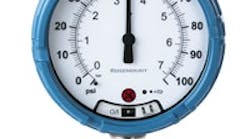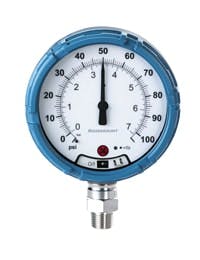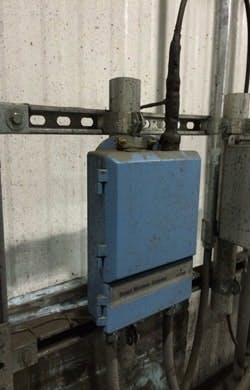Pressure gauges provide crucial information for many process operations. Traditionally, plants have relied on Bourdon tube gauges for local pressure measurements. Typically, staff responsible for a particular unit view and record readings. The data then go to the control room so operators can verify the unit is running correctly, optimize performance and ensure safety. In addition, the readings, often manually entered into a data management system, provide useful information for scheduling and performing maintenance.
Wireless pressure gauges are a relatively recent innovation. They use digital electronics to transmit continuous and automatic readings, and offer other benefits. Some, for instance, feature new pressure-sensing technology that reduces the number of mechanical components. However, the wireless instruments cost far more initially than Bourdon tube gauges and require a learning curve. So, here, we’ll examine when and why you should consider the wireless option.
[javascriptSnippet ]
Bourdon Tube Challenges
Bourdon tube gauges are a low-cost method to measure pressure. This means the gauges frequently don’t get adequate attention (Figure 1). Moreover, a variety of factors can compromise their performance.
Figure 1. While long used successfully, Bourdon tube gauges often suffer from neglect or abuse.
Process operations with high pressures or pressure spikes, such as those that often occur during startups or upsets, can cause these gauges to leak or burst, and possibly create safety issues. Meanwhile, in some cases, the process fluid entering the Bourdon tube is becoming hotter or more corrosive, resulting in gauge failure.
In addition, a gauge’s Bourdon tube and other mechanical components can fatigue and fail due to significant pulsations, such as those coming from a positive-displacement pump directly upstream. To combat these process pulsations, plants sometimes use liquid-filled gauges to dampen needle movements to decrease wear and tear. These can reduce overuse of the needle gearing and subsequent premature failure of the needle assemblies but cost more. Filling the gauge with liquid also can create problems if the liquid solidifies at low ambient temperatures, which can cause the gauge to break. Many installations address this issue with a remote seal system — but this adds significant cost.
A Bourdon tube gauge can show an incorrect reading with no clear indication of malfunction. To verify operation, a technician typically taps the gauge, for example with a wrench, to see if the needle bounces and springs back to an appropriate reading. This shows the gauge needle isn’t stuck but doesn’t confirm the gauge is working properly.
Getting the correct pressure information to where it can be utilized by facility personnel also is a challenge with traditional gauges. Many plants require operators to record readings during their rounds — with key data then entered manually into an asset management or other data storage system. This approach introduces a significant delay (hours or maybe even days) between when the data are collected and entered and thus available for use, as well as the possibility of errors such as not writing down the correct reading or making data-entry mistakes into the system.
Figure 2. Such instruments not only transmit pressure data but also device health information.
Coping With The Challenges
A wireless pressure instrument (Figure 2) addresses many issues that undermine the performance and life of a Bourdon tube gauge. Table 1 summarizes five key challenges and how wireless gauges handle them.
Let’s look at the last item in the table, expanded use of data, in a bit more detail. The wireless instrument transmits the local pressure reading to control, asset management and other host systems via a wireless mesh network such as WirelessHART. This advantage applies to any type of process measurement where a wireless instrument replaces a gauge.
Data are transmitted from each wireless instrument node, such as a pressure gauge, via the mesh network to a wireless gateway (Figure 3). WirelessHART uses the mesh network to provide redundant paths of communication as each node can receive and retransmit wireless information.
From the gateway, the information gathered from wireless pressure gauges and other wireless instruments goes to the plant’s control, asset management and other systems via hardwired links using industry standard protocols such as Modbus, OPC or HART IP across electrical connections such as RS-485 or Ethernet. Data are accessible to these systems within minutes.
Wireless data transmission clearly provides advantages but also poses cost and design issues.
Cost Considerations
Of course, all the added features found in a wireless pressure gauge as compared to a Bourdon tube gauge don’t come free. (This also applies when upgrading from any gauge to its wireless instrument equivalent.) However, hardware costs typically are easy to identify because they are clearly spelled out in the price of wireless instruments and gateways.
Basic Bourdon tube gauges cost about $100–150, while higher durability versions (e.g., with remote seals or other options) can raise the price to as much as $400. A wireless pressure gauge costs about three times as much as a higher durability gauge.
If a plant already has a WirelessHART network, adding a new wireless instrument and mapping its data to the host system data registers are simple matters that can take less than an hour.
However, if no WirelessHART network exists, the plant must put one in. The hardware costs for the network are minimal because the only requirement is to install and provide power to a WirelessHART gateway. A 100-node gateway costs about $6,000, with 25-node models available for less. Once in place, the gateway must be configured to communicate with the wireless instruments and then hardwired to the host system. This requires design time of roughly eight hours to configure the gateway to communicate with the wireless instrument and the host system.
Figure 3. A single WirelessHART gateway can collect information from many wireless instruments.
Design Considerations
Design issues aren’t always obvious. Implementing a wireless instrument system can present challenges, particularly for a facility with no existing wireless networks. Plant personnel typically are very familiar with designing, installing and maintaining wired networks — but wireless networks represent a new technology that involves a variety of special design considerations:
• Gateway configuration and connection. The gateway must be configured to gather the wireless data from instruments and provide this information to the control system. It must be connected to the host system via a hardwired digital data link.
• Gateway loading. The maximum number of devices that can be serviced by a gateway depends upon the gateway type and the update times of the devices to be connected. Tools are available to calculate gateway loading.
• Variable and diagnostic information selection. Wireless instruments can supply a very large number of variables and diagnostic messages. The user must select the information of interest from each instrument and map those data to the gateway registers for output to the host system. The mapping process requires setting the variable/diagnostic data format according to specific rules on data types and data lengths. The user needs to know the required format of the data going to the host system if native integration isn’t available. Some host systems provide native integration, which makes this task much easier — essentially plug and play.
• Wireless network best practices. Most process plants lack such best practices and so must create them. Wireless technology vendors can provide details.
• Power module life. This must be considered because very fast update rates can shorten life. With advances in lower power electronics, the modules in some wireless devices can have up to a 10-yr life. In addition, developments in power harvesting devices promise to extend module life.
• Update time. This should be set fast enough for all monitoring duties; it probably won’t be fast enough for some real-time control applications. Wireless instruments can be configured to provide updates as frequently as once per second, but this can impact power module life.
• Interference. A plant must take into account obstructions between devices and the gateway — both during initial installation and when new devices or obstructions are added. Some wireless networks can provide self-organizing mesh technology that can help mitigate interference issues.
In addition, a site must address a number of maintenance challenges:
• Training. This is recommended to help maximize benefits. It isn’t as extensive as with wired fieldbus networks because those systems are more complex.
• Terminology. Personnel responsible for installation, configuration and troubleshooting must learn new terms and definitions for the wireless world such as active advertising, stability, data reliability, etc., and how to properly apply them.
• Troubleshooting. This can be difficult initially until staff become familiar with wireless network operation and terminology. However, once through the learning curve, diagnostic information is available to simplify network management.
• Data. Wireless devices have a plethora of available variable and diagnostic data. A maintenance person must be able to sort through this list to determine what’s important and what isn’t.
Table 1. Wireless digital pressure instruments offer a number of important advantages.
Consider Going Wireless
The advantages of newer wireless pressure gauges over traditional Bourdon tube designs can make them a better choice in many demanding applications. This also is the case in other process measurement applications where wireless instruments replace gauges.
New features can provide safer installations and significantly more reliable measurements. In addition, the continuous and remote visibility of readings from the instruments allows control room operators to respond quickly and correctly to the rapidly changing process conditions often experienced during startups, shutdown and process upsets.
Bourdon tube gauges remain a good choice in many non-demanding applications but may not suffice when installed in tougher process applications and in harsh environments, particularly when the process media is corrosive or at high temperature. A variety of options can enable the gauges to handle some of these demands but they usually drive up cost. Even with all options included, gauges are limited.
When reliable pressure and other process measurements are needed in demanding applications, wireless instruments are worth considering. In these situations, their higher initial cost and additional design considerations often are more than offset by their advantages, particularly the ability to transmit readings wirelessly.
WALLY BAKER is global pressure content marketing manager for Rosemount Measurement, Emerson Process Management, Shakopee, Minn. E-mail him at [email protected].






